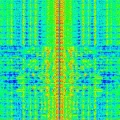A splitter to stop my KiwiSDR from overloading
I've not been able to use my 670 ft sky loop antenna with the KiwiSDR, as it causes overloading at night. I was using a homebrew splitter to pass the signal to both the KiwiSDR and netSDR. So I thought about it, and decided to make another splitter, but without the same number of turns on the two secondaries. Yes, this means the output impedance isn't correct for proper matching, but who cares, I have more than enough signal.
This splitter is wound on a binocular core, with 5 turns on the primary and one of the secondaries, and only 1 turn on the other secondary, which feeds the KiwiSDR. It seems to have solved the problem. I didn't notice any overloading early this morning on the KiwwSDR (just before sunrise when it is usually worst) and the netSDR still gets lots of signal.
It is built on the underside of a pint size paint can lid, which is then placed on the can for shielding.
There's a post about it here, with some photos: https://www.hfunderground.com/board/index.php/topic,49920.0.html
This splitter is wound on a binocular core, with 5 turns on the primary and one of the secondaries, and only 1 turn on the other secondary, which feeds the KiwiSDR. It seems to have solved the problem. I didn't notice any overloading early this morning on the KiwwSDR (just before sunrise when it is usually worst) and the netSDR still gets lots of signal.
It is built on the underside of a pint size paint can lid, which is then placed on the can for shielding.
There's a post about it here, with some photos: https://www.hfunderground.com/board/index.php/topic,49920.0.html



Comments
9690 sounds like Radio Exterior Espa?a with possibly Nigeria, which shares the frequency?
This thread: http://forum.kiwisdr.com/discussion/1238/any-ideas-am-bcb-overload/p1 contains a lot of useful information about using a KiwiSDR in a real-world environment where it will be subject to both very strong signals (local AM/Mediumwave BCB) as well as strong SWBC.
In short, if you connect the KiwiSDR to a "really good" antenna that offers broadband coverage and is fairly "flat" (some types of wire antennas like KX6QA's bowtie, the large, omni antenna such as that used at the Northern Utah WebSDR and KPH, a good, broadband E-field whip like the PA0RDT and its variants, etc.) you will have overload issues if you precede the KiwiSDR with enough gain that it can just hear atmospheric noise at the high end of the HF spectrum.
The Kiwi "only" has 14 bits of A/D, and in visiting several of the public Kiwis on SDR.HU you can find several that are at/near overload: Many of these are "wasting most of their bits" on just one or two strong AM signals - and there are a few that seem to be overloaded solely by the harmonics of a nearby switching power supply - perhaps the very one that is powering the Kiwi! Even if the Kiwi had a 16 bit A/D converter, it is likely that overloading would be a problem: Commercial radios with equal or greater A/D depth (like the Icom IC-7300 or IC-7610) would suffer the same problem if some combination of good band-pass filtering and/or appropriate use of a VGA (Variable Gain Amplifier) that maintained the input signals in the optimal range for the A/D were not used.
As noted in the thread above, there are several ways to combat overload from strong signals:
1 - Strong high-pass filter to eliminate signals below 1.8 MHz. This is a down-side if you actually want to listen to those signals.
2 - A selective means of reducing signals below 1.8 MHz - or just the 530-1700 kHz range. This includes individual notches of the strong signals and/or wholesale attenuation of the BCB - but not so much that signals are "gone".
3 - A "limited" high-pass filter that will attenuate signals below a certain frequency by a certain amount. For example, with a decent antenna you could attenuate signals below 10-12 MHz by 10-15dB (but leave the upper frequencies alone) and you would still be above the RF noise floor of even a "quiet" site: In other words, we can "see" when the antenna is connected/disconnected on the S-meter and waterfall - even at a quiet site - at 10 meters.
For the Kiwis at the Utah SDR we have to do #s 2 and 3 (plus about 15dB of amplification) to bring the Kiwi out its own noise floor by 3-ish dB or so at 10 meters, and it is only by these measures that we can do so without overloading the Kiwi - even when some of the upper bands open and signals appear.
At present, it's not very easy to tell how close one is to overloading a Kiwi (aside from having a bit of excess amplification followed by adjustable attenuation so that one "backs off" by a known amount) so until some sort of "A/D meter" is available, it can be tricky to find that balance between too little signal (e.g. most of the A/D's range is unused) and too much (at/near full-scale.)
73,
Clint
KA7OEI
But I believe the overall situation is as Clint says, that we are all trying to effectively use the 14 bits between the propagated noise floor and the top of ADC which is at about -14 dBm instantaneous. Practically this means that several big MW stations each several dB smaller than this can add together on voice peaks to drive the OV 'light' and the ADC into overload. I'v also found that 15 dB is a pretty good number for many antennas, either large antennas, e.g. 80m dipoles, running directly into 50 ohm termination of the kiwi or else small active antennas like mine running into high impedance. The latter gets coverage all the way down to audio.
I believe it is a goal that incoming noise, hopefully but from my observation too rarely, propagated 'band noise' rather than local noise, is the limiting factor. I've found that while the kiwiSDR has very good differential PS rejection-ratio, (200 mV of 160 kHz from a cheap 5V buck converter produces very little QRM) the common mode path through the KiwiSDR can be and most often is a big problem. Current injected at the LAN end of an KiwiSDR and allowed to come out via the antenna shield/ground is only about 70 dB down on the display. A well balanced and isolated 50 ohm 0 dBm source injected across the receiver "grounds" produces about an S9 signal within it. Since it's easy to collect significant common mode current from LAN, PS and Antenna cables, even with inductive choking, much of the time I believe the noise floors we are seeing are limited not by propagated noise but by noise from near field (as opposed to inverse-square-law radiative far-field) sources. The good news is that this is not radiated and there is something we can do about it. The field often falls off much more quickly with distance than would a DX (plane wave) signal. Thinking that the situation is hopeless because noise coming in from a "shielded" coax is high is a fallacy. I think too often it is common mode noise due to current in structures and ground rather than a balanced antenna.
A KiwiSDR (in normal, narrow mode) has approximately a 17 dB noise figure. Thus, in a 2.5 kHz SSB bandwidth with a termination on the input the S meter should read about -122 dBm (-174 + 17 + 34, or so). It should read only 0 to a few dB higher than this level on a quiet band from an efficient antenna such as a dipole at upper HF but only a very few of the Kiwi's on the sdr.hu map show this. Even at MF, the ITU measurements show a region which has only a few dB of 'natural' excess noise, relative to KTB. Not coincidentally, the receivers showing this are the same receivers that are leading in WSPR spots. These are not all receivers at "quiet rural locations" either. Some are residential.
In comparing sites and configurations I find that take-off-angle and ground proximity can be factors (sometimes helpful WRT noise) but that we are not at the mercy of our "noisy QTH". I have data to support this viewpoint. All of this to say that I think there is hope for significant improvement and that balancing the dynamic range with attenuators and filters, proper management of common mode current paths and choosing local antenna location wisely can go a long way towards improving our experiences.
Glenn n6gn
By my reckoning the top is 1V p-p at the ADC, or about +4 dBm in 50 ohms. Since the gain ahead of the ADC is preamp-filter_loss = 20-[2] = 18 that puts the instantaneous peak at +4-18 = -14 dBm referenced to the SMA input connector, which is about what I measure with a sinusoidal input.
If we could know (via an extension?) what the instantaneous peak was that could go a long way towards picking the right attenuation and filtering for any given situation. Up to now, I generally just watch the OV indicator while decreasing attenuation just short of the point where it comes on with a few seconds watching. Perhaps that's pretty close to optimum but there might be a few more dB of dynamic range to be had if I knew better. I'm not sure I'm the person to write such a tool but if anyone feels so inclined it would be gratefully received.
Glenn n6gn